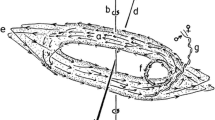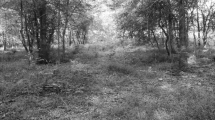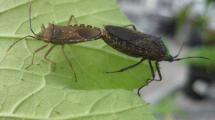Abstract
Empis borealisfemales form swarms, and males carrying a nuptial gift come to swarms to mate. Males either mated with one of the females (accepted swarms) or left swarms without mating (refused swarms). Males mated with the younger (low wing-wear) and relatively larger females in accepted swarms. They seemed to be able to judge the relative size of the females but to ignore their absolute size. Visiting males stayed shorter in accepted swarms as female size variation increased. This probably reflects their greater ease in choosing a mate among females of relatively different sizes. Females in accepted swarms tended to be larger and to have less worn wings than females in rejected swarms.
Similar content being viewed by others
References
Alcock, J. (1987). Leks and hilltopping in insects.J. Nat. Hist. 2l: 319–328.
Austad, S. N. (1983). A game theoretical interpretation of male combat in the bowl and doily spider (Frontinellapyramitela).Anim. Behav. 31: 59–73.
Bradbury, J. W. (1977). Lek mating in the hammerheaded bat.Z. Tierpsychol. 45: 225–255.
Bradbury, J. W. (1985). Contrasts between insects and vertebrates in the evolution of male display, female choice, and lek mating. In Hölldobler, B., and Lindauer, M. (eds.),Experimental Behavioral Ecology and Sociobiology, Gustav Fischer Verlag, New York, pp. 293–286.
Bradbury, J. W., and Gibson, R. M. (1983). Leks and mate choice. In Bateson, P. (ed.),Mate Choice, Cambridge University Press, Cambridge, pp. 109–138.
Chvála, M. (1976). Swarming, mating and feeding habits in Empididae (Diptera), and their significance in evolution of the family.Acta Ent. Bohemoslov. 73: 353–366.
Dodson, G. (1986). Lek mating system and large male aggressive advantage in a gall-forming tephritid fly (Diptera: Tephritidae).Ethology 72: 99–108.
Gwynne, D. T. (1981). Sexual difference theory: Mormon crickets show role reversal in mate choice.Science 231: 799–780.
Gwynne, D. T. (1986). Courtship feeding in katydids (Orthoptera: Tettigoniidae): Investment in offspring or in obtaining fertilizations.Am. Nat. 128: 342–352.
Gwynne, D. T. (1988). Courtship feeding and the fitness of female katydids (Orthoptera: Tettigonidae).Evolution 42: 545–555.
Hieber, C. S., and Cohen, J. A. (1983). Sexual selection in the lovebug, Plecia nearctica: The role of male choice.Evolution 37: 987–992.
Janetos, A. C. (1980). Strategies of female mate choice: A theoretical analysis.Behav. Ecol. Sociobiol. 7: 107–112.
Johnson, L. K., and Hubbell, S. P. (1984). Male choice. Experimental demonstration in a brentid weevil.Behav. Ecol. Sociobiol. 15: 183–188.
Petrie, M. (1983). Mate choice in role-reversed species. In Bateson, P. (ed.),Mate Choice, Cambridge University Press, Cambridge, pp. 167–179.
Quinn, J. S., and Sakaluk, S. K. (1986). Prezygotic male reproductive effort in insects: Why do males provide more than sperm?Fla. Entomol. 69: 84–94.
Rutowski, R. L. (1982). Mate choice and lepidopteran mating behavior.Fla. Entomol. 65: 72–82.
Sakaluk, S. K. (1986). Is courtship feeding by male insects parental investment?Ethology 73: 161–166.
Smith, R. L. (1980). Evolution of exclusive postcopulatory paternal care in the insects.Fla. Entomol. 63: 65–78.
Svensson, B. G., and Petersson, E. (1987). Sex-role reversed courtship behaviour, sexual dimorphism and nuptial gifts in the dance flyEmpis borealis (L.).Ann. Zool. Fenn. 24: 323–334.
Svensson, B. G., and Petersson, E. (1988) Non-random mating in the dance flyEmpis borealis: The importance of male choice.Ethology 79: 307–316.
Thornhill, R. (1976). Sexual selection and parental investment in insects.Am. Nat. 110: 158–163.
Thornhill, R. (1980). Sexual selection within mating swarms of the lovebug,Plecia nearctica (Diptera: Bibionidae).Anim. Behav. 28: 405–412.
Thornhill, R. (1981).Panorpa scorpionflies: Systems for understanding resource-defence polygyny and alternative male reproductive efforts.Annu. Rev. Ecol. Syst. 12: 355–386.
Thornhill, R., and Alcock, J. (1983).The Evolution of Insect Mating Systems, Harvard University Press, Cambridge, Mass.
Thornhill, R., and Gwynne, D. T. (1986). The evolution of sexual differences in insects.Am. Sci. 74: 382–389.
Trivers, R. L. (1972). Parental investment and sexual selection. In Campbell, B. G. (ed.),Sexual Selection and the Descent of Man, Heinemann, London, pp. 136–179.
Tuomikoski, R. (1939). Beobachtungen uber das Schwärmen und die Kopulation einiger Empididen (Dipt.).Ann. Entomol. Fenn. 5: 1–30.
Author information
Authors and Affiliations
Rights and permissions
About this article
Cite this article
Svensson, B.G., Petersson, E. & Forsgren, E. Why do males of the dance flyEmpis borealis refuse to mate? The importance of female age and size. J Insect Behav 2, 387–395 (1989). https://doi.org/10.1007/BF01068063
Accepted:
Issue Date:
DOI: https://doi.org/10.1007/BF01068063




